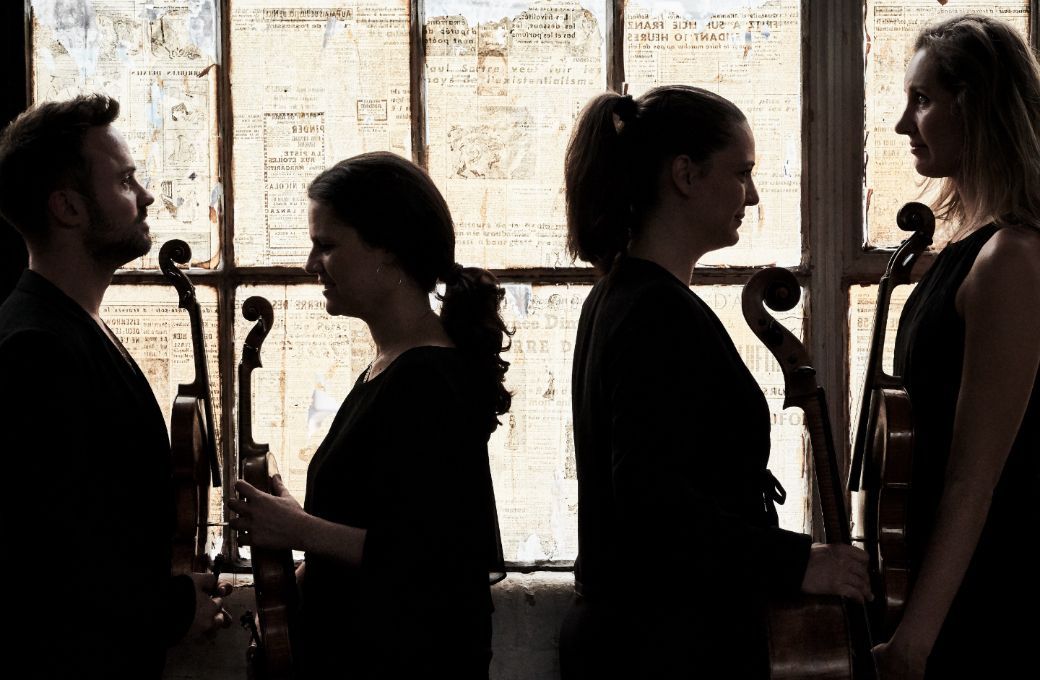The Elias String Quartet are the first British quartet to perform the entire Beethoven string quartet cycle at Tokyo’s Suntory Hall. Founded in Manchester in 1998, they have become known for their virtuosity and bold choices in performances of Beethoven.

Complete Beethoven string quartet cycles performed during festivals provide unique opportunities for musicians to share their explorations, and to develop relationships with their audiences. Three key variables can illuminate the interpretive choices and musical results: the number of times a group has performed the cycle, the order in which the individual works are programmed, and how the Grosse Fuge will be handled.
The importance of the Grosse Fuge in a Beethoven cycle cannot be overstated. This piece, which originally served as the finale of String Quartet no. 13 Op.130, is a challenging work, and has been the subject of continued debate among scholars and musicians. Some quartets choose to perform the Grosse Fuge alone, as the finale of the cycle, while others place it in its original context as the finale of Op.130. If the Fuge is played as a standalone, an alternative Allegro finale to Op.130 is used – a lighter movement, and a little sardonic, though challenging nonetheless. Written by Beethoven in response to his publisher’s request for a more commercial way to end the quartet, the movement itself contains an oblique reference to the Fuge in its harmonic progression.
A second variable is how the cycle will be programmed. The usual choice is to have one from the early, middle and late periods on each program, often chosen to illustrate a thematic or instructive schematic plan. Less usual and perhaps more mind-bending is presenting the works in the order in which they were composed, allowing audiences to experience Beethoven’s development as a composer over time while putting tremendous strains on the players and listeners alike.
The third variable is how many times the players have performed these works before. Some quartets may have played these cycles numerous times, while others may be approaching them for the first time.
For the Elias String Quartet, this will be their 15th complete Beethoven cycle since their founding in 1998. Their first took place in 2011–15 at venues across the UK, with the Wigmore Hall cycle recorded live for CD release. Their six concerts at Suntory Hall will feature one quartet each from Beethoven’s early, middle and late periods, chosen to evoke “opposites.” They will perform the Quartet Op.130 twice, with the Allegro movement on June 5th, and with the original Grosse Fuge ending on June 14th.
Violinist and founding member Donald Grant told me by video chat that the more he’s played the cycle, the less he hears the conventional division into early, middle and late. “What I do hear is Beethoven exploring the same issue in different phases, in the process of developing his hugely experimental music.” On playing the cycle with an early, middle and late quartet on each instalment, Grant comments that it’s “fascinating to see them all next to each other in that way. They make really good programs.”
In the same conversation both Grant and violist (since 2018) Simone van der Giessen enthusiastically agrees that playing Opus 130 twice makes sense. “When you play the Grosse Fuge,” Giessen says, “it has the impact it does because of what’s been preceding it. And we feel that we are playing the entire piece very differently according to whether we’re using the Grosse Fuge or the alternative ending, and that it even becomes a different work. So we wanted to include it that way both times. And it’s the most glorious music so we don’t mind playing it twice.”
“There’s no doubt,” Grant adds, “that for the audience that replacement Finale is a completely different emotional experience. It’s like what Beethoven does at the end of his Opus 135 and Opus 95 Quartets where all of a sudden, through all his searching, he finds the lightness and the fun. One of our teachers said about these moments, ‘This is Beethoven saying, this is It!’
“With the Grosse Fuge it’s the absolute opposite. It feels like the most almighty battle in the world. The Grosse Fuge by itself doesn’t work for me at all. As an isolated movement, I find it very hard to understand. It didn’t make sense to me,” Grant admits, “until I had performed it with Opus 130 – and then the structure really made sense: a huge first movement and the huge Grosse Fuge with all the utterly varied movements in between. Then it makes sense emotionally.”
Overall, Grant marvels at the freedom and range of Beethoven’s music. “A piece like Opus 131, in seven movements without a break, immerses you in every single emotion you could possibly feel expressed in music – and takes you to a place where you experience through music an unleashing of emotional depths that you didn’t know were possible. That is how it is for us. I hope it is the same experience for the audience.”
When the Elias last played the Beethoven cycle, in March and April 2022 at Hobby Center in Houston, they played them in chronological order. Giessen says she would “love to do it again that way, because to turn the page after each quartet, and move to the next, gives you the feeling that you are really close to the process that Beethoven went through. Even though the concert with the three Opus 59 quartets was incredibly tiring physically, it was an amazing thing to do.”
The Elias had an opportunity to hear the cycle through fresh ears when Giessen joined. “As soon as you have a new member,” Grant says, “everything adapts and, and morphs. It’s really useful because it’s so easy to get into habits when you’ve played a piece for a long time. With a new member, you re-assess the score. You go back further. When you see it through some someone else’s eyes, it’s like you’re seeing it for the first time. That’s incredibly valuable.” Grant cites the sorts of questions that come up in rehearsals – “Do you mean to have this tempo? Do you mean to play this dynamic here? – things that had become invisible to us.”
Newcomer Giessen says, “I knew the quartets, and a few of them intimately. Then there were a few Quartets which I had never played. For instance, Opus 135 was pretty new to me. I observed something very curious. When you start playing them, you might assume in your head how the music looks on the page but it can look very different and could even be written in a different time signature or key than you had thought. You really have to go back to the score and see how Beethoven wrote it.”
When new players join established quartets, the issue of whether their four instruments blend is usually of paramount interest. In the case of the Elias Quartet, however, they didn’t talk about it too much. “I think my instrument fits quite nicely,” Giessen says. “It’s warm with a centred sound. It blends easily with the others.”
Grant prefers to talk about his new violist. “I’m personally not so interested in instruments. The difference when a new player joins is the player not the instrument. Simone’s viola was a small fraction of her newness – the newness was Simone. Of course, we’ve had different members with different instruments and some combinations have worked better than others, but I think anything’s possible when there’s the will to make it work.”
Grant says that the Quartet has always wanted to go to Japan. “To have the chance to be in Tokyo for that length of time, to get to know the audience, the hall, is something unique that we won’t forget. A Beethoven cycle in a short period of time is not the usual concert-going experience,” he adds. “In Houston we had a party with the audience after the last concert and got to chat with them. It was special and touching to hear what they had thought and felt along with us throughout the cycle.”
The Elias String Quartet perform their complete cycle of Beethoven string quartets from 3rd–14th June, at Suntory Hall, Tokyo.
This article was sponsored by Suntory Hall.


